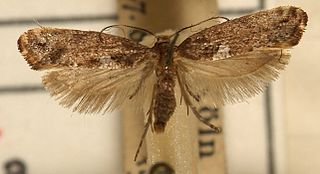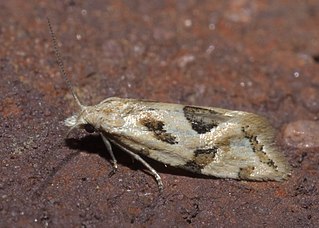
The Acrolepiidae are a family of moths known as false diamondback moths. In modern classifications, they are often treated as a subfamily (Acrolepiinae) of the family Glyphipterigidae.

Copromorphidae, the "tropical fruitworm moths", is a family of insects in the lepidopteran order. These moths have broad, rounded forewings, and well-camouflaged scale patterns. Unlike Carposinidae the mouthparts include "labial palps" with the second rather than third segment the longest. With other unusual structural characteristics of the caterpillar and adult, it could represent the sister lineage of all other extant members of this superfamily. The genus Sisyroxena from Madagascar is also notable for its unusual venation and wing scale sockets.

Argyresthia is a genus of moths in the family Argyresthiidae, previously treated as subfamily Argyresthiinae in the family Yponomeutidae.

Aroga is a genus of moths in the family Gelechiidae.

Filatima is a genus of moths in the family Gelechiidae.

Gnorimoschema is a genus of moths in the family Gelechiidae.
Prolita is a genus of moths belonging to the family Gelechiidae.

Euclemensia woodiella, the Manchester tinea, is a yellow and brown British moth. It is regarded as extinct, and is known from only three museum specimens, one of which is held by the Manchester Museum, one by the Natural History Museum, London, and the type, which is in the Curtis Collection at Museum Victoria.

Aethes is a genus of moths belonging to the subfamily Tortricinae of the family Tortricidae.

Henricus is a genus of moths belonging to the family Tortricidae.

The Depressariinae – sometimes spelled "Depressiinae" in error – are a subfamily of moths in the superfamily Gelechioidea. Like their relatives therein, their exact relationships are not yet very well resolved. It has been considered part of family Elachistidae sensu lato or included in an expanded Oecophoridae. In modern classifications they are treated as the distinct gelechioid family Depressariidae.

Crocidosema lantana, the lantana flower-cluster moth or lantana tortricid moth, is a moth of the family Tortricidae. It was first described by August Busck in 1910. It is native to Mexico and the southern United States, but was introduced to Hawaii in 1902, Australia in 1914 and the Caroline Islands in 1948 and 1949 to aid in the control of Lantana weeds. It has also been recorded from Yunnan, China and in Sri Lanka.

Stagmatophora wyattella, or Wyatt's stagmatophora moth, is a moth in the family Cosmopterigidae. The species was first described by William Barnes and August Busck in 1920. It is found in the US states of Maine, Ohio, Iowa, Kentucky, Michigan, Mississippi and Oklahoma.

Agonopterix is a moth genus of the superfamily Gelechioidea. It is placed in the family Depressariidae, which was often – particularly in older treatments – considered a subfamily of the Oecophoridae or included in the Elachistidae.

Cerconota is a genus of moths in the family Depressariidae. In 1991, I. W. B. Nye and David Stephen Fletcher included it in the family Oecophoridae and the subfamily Stenomatinae. It was later placed in the family Elachistidae and subfamily Stenomatinae by Ronald W. Hodges, in Niels Peder Kristensen (1999). Other classifications placed them in the Elachistidae or Oecophoridae, but they actually seem to belong to the Depressariidae.
Euclemensia schwarziella is a moth in the family Cosmopterigidae. It was described by August Busck in 1901. It is found in the US states of Arizona and Texas.

Euclemensia bassettella, the kermes scale moth, is a moth in the family Cosmopterigidae. It was described by James Brackenridge Clemens in 1864. It is found in North America in New Hampshire, southern Ontario, Illinois and from Florida to eastern Texas. The species lives on or near oak trees infected with scale insects.

Gerdana is a genus of moths in the family Autostichidae. It contains only one species, Gerdana caritella, which is found in North America, where it has been recorded from southeastern Canada and the eastern United States.
Apatetrinae is a subfamily of moths in the family Gelechiidae. The subfamily was described by Edward Meyrick in 1947.

Pseuderotis obiterella is a moth in the family Depressariidae. It was described by August Busck in 1908. It is found in North America, where it has been recorded from Florida, Georgia, Mississippi, North Carolina, South Carolina and West Virginia.

















